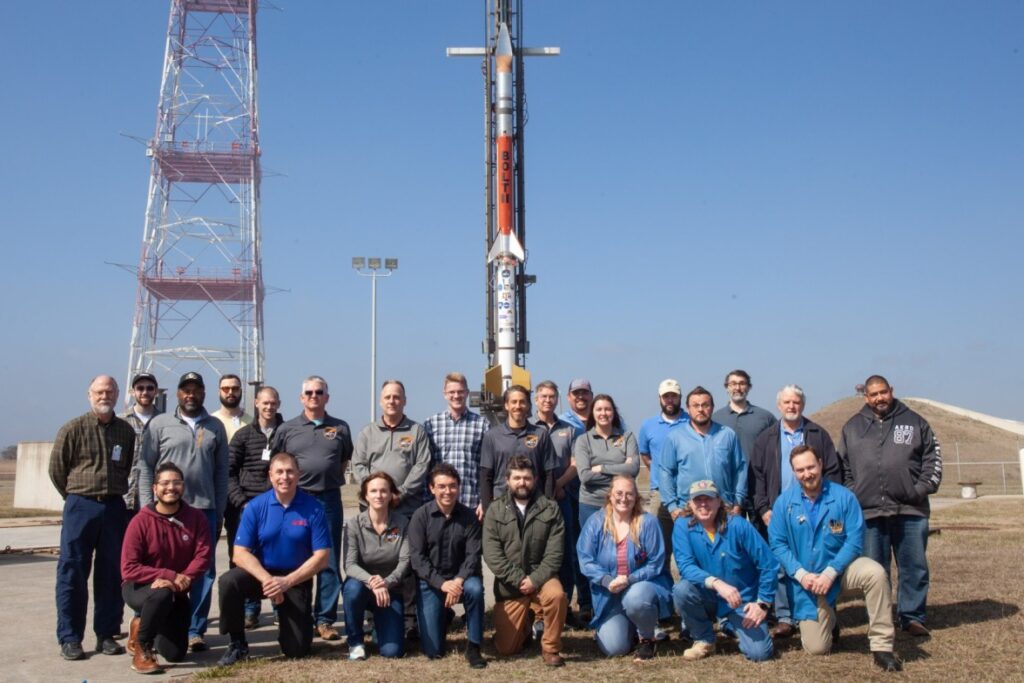The successful launch of BOLT II by NASA could usher in a new era of hypersonic travel.
WRIGHT-PATTERSON AIR FORCE BASE, Ohio (AFRL) March 23, 2022 – The BOLT II “In memory of Mike Holden” flight experiment, managed by the Air Force Research Laboratory/Air Force Office of Scientific Research (AFRL/AFOSR), launched on the evening of March 21 from the National Aeronautics and Space Administration’s (NASA) Wallops Flight Facility in Virginia. Dr. Michael Holden, who, up until his passing in 2019, had been a leader in the hypersonics field since the 1960s. The flight experiment successfully flew the planned flight path and acquired tremendous scientific data to further our understanding of boundary layer transition, turbulent heating, and drag at hypersonic conditions.
Hypersonic vehicles can travel at speeds far faster than passenger aircraft, allowing for extremely fast flights that cut travel time in half. In comparison to the present 6-7 hour non-stop flight from New York to Paris, the trip will take only 90 minutes.
The goal of the AFRL/AFOSR BOLT II flight experiment is to collect scientific data to better understand Boundary Layer Transition (BOLT) and Turbulence (BOLT II) during hypersonic flight. Monday’s successful launch of the two-stage suborbital-sounding rocket has paved the way for the next chapter of discovery in this area of basic research.
Also Read: NASA’s LBFD to make supersonic flight possible on land.

“The flight experiment was designed to provide access to hypersonic boundary layer turbulence measurements in a combination of low-disturbance air and high Reynolds numbers seen in flight, but that are not achievable in ground test facilities,” said Dr. Sarah Popkin, who oversees the AFRL/AFOSR BOLT II project as AFOSR’s Program Officer for High-Speed Aerodynamics.
“The experimental vehicle included over 400 sensors geared toward correlating surface pressure, heat flux, and skin friction in a hypersonic boundary layer. The two-sided experiment seeks to understand both “natural” and “tripped” turbulent boundary layer development,”
said Dr. Sarah Popkin.
The BOLT II science team is led by Texas A&M University with key collaborators at NASA, CUBRC, University of Minnesota, United States Air Force Academy, University of Maryland, University of Arizona, and Johns Hopkins University Applied Physics
Laboratory; along with international collaboration from Australia’s Defence Science and Technology Group and the University of Queensland.

As well, team members at AFRL’s Aerospace System’s Directorate have been instrumental in this project by doing a lot of the heavy lifting ensuring that the entire team was able to successfully collect the data needed from the experiment.
Strategic partnerships like these are vital to AFRL/AFOSR’s basic research success. By creating and supporting opportunities for highly diversified partnerships such as these, AFRL/AFOSR can also provide important pathways to build the next generation of scientists and engineers who can solve difficult problems and contribute to modernizing the future science and technology needs for the nation.
Similar to the BOLT I program, BOLT II included a symbiotic trio of wind tunnel testing, high-fidelity computations, and a flight experiment. The wind tunnel and computational data acquired during the BOLT II project informed the design and placement of over 400 sensors to capture correlations needed to, in turn, improve and validate boundary layer turbulence models.
Unique to BOLT II, this project provided the first-ever full-scale ground testing of the flight geometry. Post-processing of the flight data will be directly compared to the earlier entry into the CUBRC LENS II shock tunnel. This facility replicated the Mach and Reynolds number conditions expected for the BOLT II trajectory but at higher, conventional disturbance air conditions.

“The results from these two data sources provide a one-of-a-kind direct comparison between ground and flight experiment conditions with identical hardware. A second, full-scale wind tunnel test campaign, is being carried out by the University of Queensland, which is also matching flight conditions and simulating vehicle surface heating observed during flight,”
said Popkin.
“Words cannot express how grateful and happy I am that we have reached this moment. Absolutely, we would not be where we are without our amazing team and I’m excited to see what the data will teach us about high-speed turbulence,”
said Popkin.
Dr. Rodney Bowersox, professor of aerospace engineering at TAMU and lead principal investigator on BOLT II, couldn’t agree more, “I am very grateful to have been a part of this great team effort involving multiple research groups at TAMU, including Dr. Helen Reed and Dr. Edward White and the cadre of brilliant students, CUBRC, AFRL, NASA, NASA Sounding Rocket Operations Contract (NSOROC), Lockheed Martin, other universities, and most importantly AFRL/AFOSR. I am confident the data obtained will serve the scientific research community for many years to come. Mike [Holden] would be very proud.”
BOLT II shows how the Air Force Research Laboratory and the Air Force Office of Scientific Research continue to uncover, shape, and champion daring, high-risk, high-reward basic research for the US Air Force and Space Force. As the AFRL/AFOSR commemorates 70 years of innovation, this heritage will be carried on through strategic investments in basic research initiatives that dive deep into scientific transformative ideas and conceptions that pave the way for new technologies, products, and capabilities. BOLT II also emphasizes the importance of fundamental research as a long-term investment that requires dedication and a well-thought-out approach.
About AFRL
The Air Force Research Laboratory (AFRL) is the primary scientific research and development center for the Department of the Air Force. AFRL plays an integral role in leading the discovery, development, and integration of affordable warfighting technologies for our air, space, and cyberspace force. With a workforce of more than 11,500 across nine technology areas and 40 other operations across the globe, AFRL provides a diverse portfolio of science and technology ranging from fundamental to advanced research and technology development. For more information, visit: www.afresearchlab.com.

